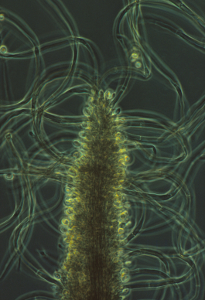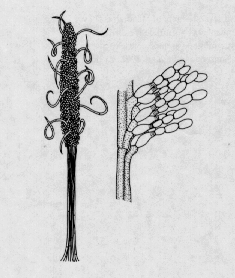Main page <> Index of descriptions <> Previous description <> Trichurus <> Next description
Trichurus


The brown conidiophores are united to form large complex cylindrical structures (synnemata) bearing a dense layer of annellides on the upper half. Curved to straight sterile hairs project out from among the annellides. The spores (conidia) are colourless to brown and are produced in chains from the tips of the annellides. Similar and possibly congeneric with Cephalotrichum.
Shoemaker and Kokko (1977) discussed four species and Udagawa et al (1985) added a fifth, T. dendrocephalus. These species can be distinguished with the following key:
1. Sterile hairs straight - 2
1. Sterile curved or definitely wavy - 3
2. Sterile hairs usually unbranched. Spores 4-9 X 3 Á - T. cylindricus
2. Sterile hairs forked. Spores 3.0-6.0 X 2.0-3.5 Á - T. terrophilus
3. Sterile hairs branched - T. dendrocephalus
3. Sterile hairs unbranched - 5
4. Spores ashy grey in mass - T. gorgonifer
4. Spores yellow-brown in mass - T. spiralis
Occurring in soil, dung, and plant debris.
Classification: Microascaceae. Holomorph unknown. Ref: Ellis 1971; Shoemaker and Kokko 1977; Swart 1964; Udagawa et al 1985